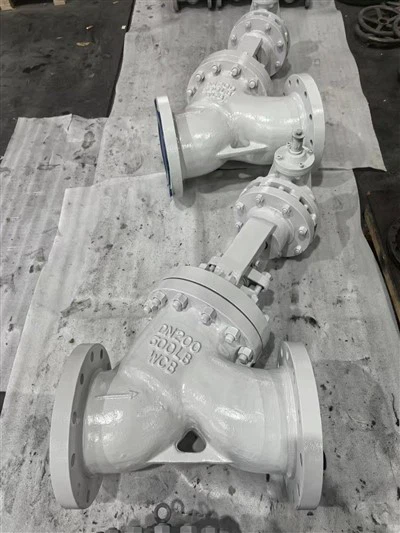As a supplier of Swing Type Check Valves, I understand the critical role these valves play in fluid systems. One of the most significant challenges they face is water hammer, a phenomenon that can cause severe damage to the valve and the entire piping system. In this blog, I will share some effective strategies on how to protect a Swing Type Check Valve from water hammer.
Understanding Water Hammer
Water hammer is a pressure surge or wave caused when a fluid in motion, usually water, is forced to stop or change direction suddenly. This sudden change in velocity creates a shock wave that travels through the pipe, resulting in high-pressure spikes. These spikes can be several times higher than the normal operating pressure of the system, leading to noise, vibration, and potential damage to the valve and piping components.
The main causes of water hammer in systems with Swing Type Check Valves include:


- Sudden Valve Closure: When the flow in the pipeline reverses, the Swing Type Check Valve closes to prevent backflow. If the closure is too rapid, it can generate a significant water hammer effect.
- Pump Startup and Shutdown: Starting or stopping a pump suddenly can cause a rapid change in flow velocity, leading to water hammer.
- Flow Rate Changes: Abrupt changes in the flow rate, such as those caused by the opening or closing of other valves in the system, can also trigger water hammer.
Strategies to Protect Swing Type Check Valves from Water Hammer
1. Proper Valve Sizing and Selection
- Correct Sizing: Ensure that the Swing Type Check Valve is correctly sized for the specific application. An oversized valve may close too slowly, allowing significant backflow and potentially causing water hammer. On the other hand, an undersized valve may cause excessive pressure drops and turbulence, increasing the risk of water hammer.
- Selecting the Right Type: Consider the characteristics of the fluid and the system when selecting a valve. For example, in applications where water hammer is a concern, a Single Plate Wafer Type Check Valve may be a better choice due to its quick closing time and ability to reduce backflow.
2. Installing Surge Suppressors
- Air Chambers: Air chambers are simple and effective devices for reducing water hammer. They consist of a vertical pipe or tank filled with air that acts as a cushion to absorb the shock waves generated by water hammer. Install an air chamber near the Swing Type Check Valve to dampen the pressure spikes.
- Surge Tanks: Surge tanks are larger than air chambers and can store a significant amount of fluid. They are designed to absorb and release fluid during pressure surges, helping to maintain a stable pressure in the system. A well-designed surge tank can effectively protect the Swing Type Check Valve from water hammer.
- Hydraulic Accumulators: Hydraulic accumulators are similar to surge tanks but use a gas-charged bladder or piston to store and release energy. They can respond quickly to pressure changes and are particularly useful in high-pressure systems.
3. Using Slow-Closing Devices
- Damped Hinges: Some Swing Type Check Valves are equipped with damped hinges that slow down the closing speed of the valve. This helps to reduce the impact of the valve closing and minimize the water hammer effect.
- Oil Dashpots: Oil dashpots are another type of slow-closing device that can be added to the Swing Type Check Valve. They use the resistance of oil to slow down the movement of the valve disc, preventing sudden closure.
4. Proper System Design and Operation
- Gradual Flow Changes: Avoid sudden changes in flow rate by using valves with slow-opening and slow-closing capabilities. For example, install a Lift Type Check Valve upstream of the Swing Type Check Valve to control the flow more gradually.
- Pump Control: Implement proper pump control strategies to prevent sudden startup and shutdown. Use soft starters or variable frequency drives (VFDs) to gradually increase or decrease the pump speed, reducing the risk of water hammer.
- Pipeline Layout: Design the pipeline layout to minimize sharp bends, elbows, and sudden changes in diameter. These features can cause turbulence and increase the likelihood of water hammer. Use smooth, gradual curves and maintain a consistent pipe diameter throughout the system.
5. Regular Maintenance and Inspection
- Valve Maintenance: Regularly inspect and maintain the Swing Type Check Valve to ensure it is functioning properly. Check for signs of wear, corrosion, or damage to the valve disc, seat, and hinge. Replace any worn or damaged components promptly to prevent water hammer caused by valve malfunction.
- System Monitoring: Install pressure sensors and flow meters in the system to monitor the pressure and flow rate. This allows you to detect any abnormal pressure spikes or flow changes that may indicate the presence of water hammer. Take appropriate action immediately to prevent damage to the valve and the system.
Conclusion
Protecting a Swing Type Check Valve from water hammer is essential for ensuring the reliable operation of the fluid system. By following the strategies outlined in this blog, including proper valve sizing and selection, installing surge suppressors, using slow-closing devices, implementing proper system design and operation, and conducting regular maintenance and inspection, you can effectively reduce the risk of water hammer and extend the lifespan of your valve.
If you are looking for high-quality Swing Type Check Valves or need further advice on protecting them from water hammer, please feel free to contact us. Our team of experts is ready to assist you in finding the best solutions for your specific application.
References
- Crane, D. (2000). Flow of Fluids Through Valves, Fittings, and Pipe. Technical Paper No. 410. Crane Co.
- Miller, D. S. (1990). Internal Flow Systems. BHRA Fluid Engineering.
- Streeter, V. L., & Wylie, E. B. (1979). Fluid Mechanics. McGraw-Hill.





